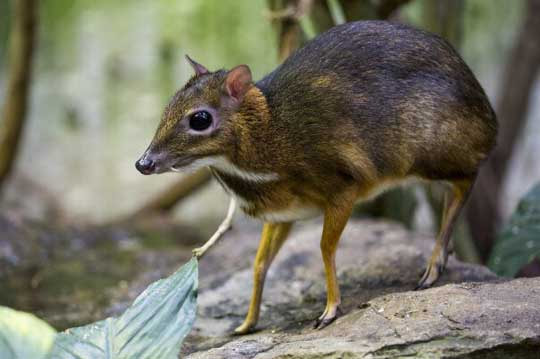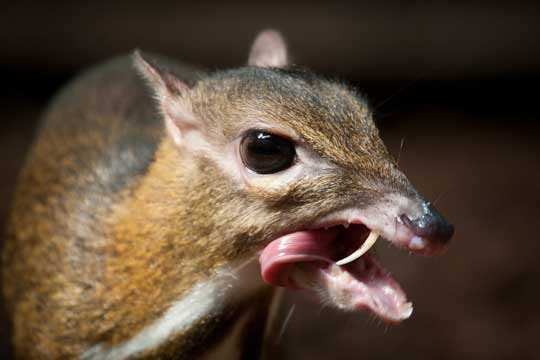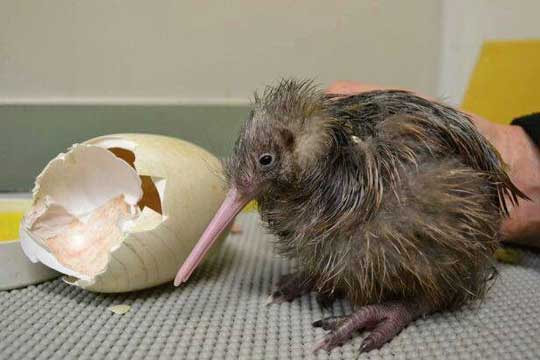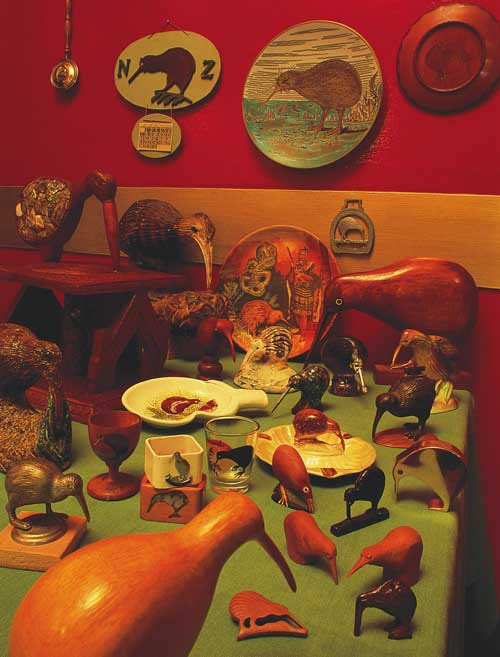|
Thanks to reader Debbi Dieter for suggesting this creature. In the United States, there are only two species of deer (white-tailed deer and mule deer), which typically grow to 200 to 300 pounds (90-136 kg). However, we have a few other ungulates (hoofed animals that walk on the tips of their toes), such as elk, moose, bison, mountain goats, and others (yes, I know elk and moose are technically deer). Some of these other ungulates, like the moose, can grow to 1,500 pounds (680 kg). And when we consider ungulates from other parts of the world, some of them, like the white rhinoceros, can weigh up to 9,900 pounds (4,500 kg). In other words, ungulates are generally BIG animals. So, what's the smallest of all the ungulates? It turns out to be the mouse deer, also known as the Chevrotain. What the heck is a Chevrotain? Chevrotains are small ungulates that live in the forests of South and Southeast Asia (and one of the species lives in Africa). The smallest of these, the Java mouse deer, is the size of a rabbit, usually weighing only 2.2 to 4.4 pounds (1-2 kg). Mouse deer are not actually true deer (although they are ungulates). They belong to the family, Tragulidae. There are a number of extinct species in this family, and the ten species alive today are all that's left of this ancient group. Amazing facts about Chevrotains Mouse deer are in an old family. This group of mammals originated about 34 million years ago, and they haven't changed much since then. They are considered primitive ruminants. Ruminants are mammals that get their nutrients from plants by having the consumed plant material ferment (with the help of microbes) in specialized stomach compartments before going into the rest of the digestive system. Chevrotains have four stomach chambers for this, but the third chamber is poorly developed compared to that of more modern ruminants. Chevrotains are thought to be a stepping stone between ungulates with simple stomachs (like pigs) and ungulates with highly-evolved four-chambered stomachs (like true deer and cows). Mouse deer do not have antlers or horns. But they do have something unusual—elongated teeth, or tusks. Why does a tiny little ungulate have tusks? Well, only the males have these tusks, and they use them when they fight each other. Why do they fight each other? To compete for mates, of course. This is the same reason many other ungulate males fight. The male deer that live around our house get into these nasty shoving matches using their pointed antlers. Bighorn sheep males charge at each other and smash their brains out (not literally) in a head-on collision. And the little chevrotain males slash at each other with their sharp tusks. It's all about being dominant. Good thing humans aren't like that, right? Hmm... Chevrotains have extremely thin legs and feet. With those tiny legs, they can't turn very quickly, but the legs do help them run through the thick brush of their forest habitat. Chevrotains have mysterious blood. First of all, they have the smallest red blood cells of any mammal. As far I can tell, no one knows why their cells are so small. Not only that, but about 13% of their red blood cells have little pits in the cell surface. These pits have never been observed in the blood cells of any other animal, and we simply do not know what function they serve. See the pits in electron microscope image below. Also note that the red blood cells are almost round (spherical), which is another unusual characteristic. Weird. After a very long gestation period of 7 to 9 months, chevrotain females give birth to only one young. But... they usually mate again within an hour or two after giving birth. And they continue to do that throughout their adult life, breeding and giving birth all year round. Wow, that means the females are pregnant almost their entire lives! The young are very well-developed when they are born, and within 30 minutes they can stand and run around at full speed. Now this little tidbit of information is particularly unusual for an ungulate. Several species of chevrotains are water lovers. In fact, the species that lives in Africa is called the water chevrotain. This creature will dive into the water whenever it senses a predator is near. They sink to the bottom and actually walk along the stream bed. To keep the current from carrying them away, they scrunch down to reduce the water resistance, and they also grab hold of submerged plants. They can stay under water this way for four minutes! Then they slowly move to the edge of the stream and discretely raise their nose up and take another breath, thus avoiding the predator until it gets bored with waiting and goes off in search of easier prey. Check out this video of a water chevrotain avoiding an eagle. One more interesting fact. Another way that the chevrotain responds to danger is to stomp its feet (actually, large species of deer do this, too). Chevrotains can stomp four to seven times per second, creating a "drum-roll" sound to warn other chevrotains in the area that a predator is near. So, the chevrotain deserves a place in the F.A.H.O.F. (Fabulicious Animal Hall of Fame). FUN FACT: Well, the word fabulicious is obviously a combination of fabulous and delicious. The word fabulous originated way back in about 1540, and it has roots in the word fable. In other words, it referred to something too amazing to be true. And the word delicious originated even earlier, about 1250, and it meant very pleasing or delightful (especially in smell or taste). At some point, some brilliant person decided these two words belonged together, and thus fabulicious was born. So, fabulicious is another way to say awesome! Photo Credits:
Mouse Deer #1 - The Washington Post Mouse deer tusk - Arjan Haverkamp via Flickr Mouse deer blood cells - K. Fukuta, H. Kudo and S. Jalaludin, Journal of Anatomy Mouse deer with baby - ZooBorns Mouse deer stomping feet - ZooBorns
0 Comments
Did you know the only mammals native to New Zealand are a few species of bats and some marine mammals (whales, dolphins, and seals)? For this reason, the Kiwi is sometimes called New Zealand's "honorary mammal." But the Kiwi, or course, is actually a bird. Wait! Did you think I was referring to those little brown, fuzzy fruits in the produce section at the market? Nope, those are actually called kiwifruit. And they definitely are not birds. Wait again! Did you think I was referring to New Zealanders? The people of New Zealand have been referred to as Kiwis since the nickname was given to them during World War I. Again, nope... I'm not talking about the people. Speaking of New Zealanders, you might think my statement above about the only native mammals being bats and sea mammals is incorrect. After all, humans are certainly mammals, so wouldn't we consider the Maori people to be mammals native to New Zealand? Well, maybe, but the Maori people discovered and settled in New Zealand only 740 years ago (close to the year 1280). That certainly makes them indigenous to the island, but 740 years isn't long compared to the 50 million years since the first kiwis appeared! What the heck is a Kiwi? Kiwis consist of five bird species living only on New Zealand. They are in the group of large, flightless birds called ratites, which includes ostriches, emus, cassowaries, rheas, and some species that are now extinct. Kiwis are the smallest (by far) of all the ratites. Perhaps their most distinguishing characteristic is that they are flightless ground birds. Amazing facts about Kiwis The genetic heritage of kiwis is confusing. They shared the island of New Zealand with an extinct type of ratites, the 500-pound (227 kg) moa. So, you would think kiwis are closely related to moas. But, DNA evidence has shown that kiwis are more closely related to the elephant birds (also extinct) from Madagascar. And regarding living species, kiwis are more closely related to the emus and cassowaries than to the moas. How can this be possible? Well, studies have shown that the ancestor of kiwis, a bird called Proapteryx, was probably capable of flight, suggesting that kiwi ancestors migrated to New Zealand separate from moas (moas were already large and flightless when the kiwi ancestor arrived on the scene). Kiwis are about the size of chickens. The largest, the great spotted kiwi, weighs about 7.3 pounds (3.3 kg), and the smallest, the little spotted kiwi, weighs 2.9 pounds (1.3 kg). I mentioned above that kiwis are sometimes referred to as "honorary mammals." Part of the reason for this is that they appear to be covered in fur, but this is actually thin, hair-like feathers. Kiwis have really strong legs. Amazingly, a kiwi's muscular legs make up about a third of its entire body weight! With these powerful legs, kiwis can run as fast as a human. In a single night, a kiwi can cover its entire territory, which is often hilly and difficult to traverse. How big is an individual's territory? Up to the size of 60 football fields. That's 79 acres (32 hectares)! Okay, this may be the most impressive thing about kiwis. These birds typically lay one egg per season, but that one egg is the largest egg (relative to their body size) of any other bird. Consider this... a human baby is typically about 5% of the weight of the mother giving birth. And (drumroll please...) the kiwi's egg can be a whopping 25% of the mother bird's weight. Let's put this into perspective. This would be like a 150-pound (68 kg) woman giving birth to a 37-pound (16.8 kg) baby. Yeeeouch! Let's look at it another way. A kiwi is about the size of a chicken, but a kiwi's egg is six times the size of a chicken's egg. If you think this might be hard on the female kiwi, you're right. During the 30 days it takes to grow the egg in her body, the female must eat three times the amount of food she normally eats. But for the last three days or so of that time, the egg gets so large that there is no room left for her to eat at all, and she must go hungry. However, there is relief for her after the egg has been laid. In four of the five kiwi species, the male is the one to incubate the egg, a process that takes 63 to 92 days (in the fifth species, both parents share the task). That's the least the male can do after all that, right? Check out the X-ray below. How are kiwis able to have such large eggs? Three reasons: First, as you can imagine, kiwis would not be able to develop such large eggs if they weren't ground birds. It would be too much weight to carry in flight. Second, kiwis typically live in areas with abundant food, allowing them to take in enough nutrients to support the development of these huge eggs. And third, until recently, when humans introduced predators to New Zealand, kiwis historically had few natural predators (which might eat the eggs or easily catch the mothers, which are slowed down by the weight). Once the egg has been laid and incubated, the kiwi baby has to kick its way out of the egg when it hatches. Unlike other birds, kiwi babies do not have an egg tooth. Since they grow so large inside the egg, and since incubation is so long, the babies hatch with a full coat of hair-like feathers. Most baby birds have that "ugly-baby-bird" look, but baby kiwis simply look like smaller versions of the adults. You know how birds that fly have hollow bones to make them lighter? Well, kiwis have marrow in their bones (like mammals), making them heavier than other birds their size. It may look like kiwis have no wings, but they actually do. The wings are only about an inch (3 cm) long and are usually hidden beneath the hair-like feathers. Each wing has a claw on the tip, but no one really knows the purpose of this claw. Kiwis' beaks are quite different from those of other birds. Their beaks are long, yet they are pliable and sensitive to touch. And kiwis are the only birds with nostrils at the end of the beak. These special beak features allow them to stick their beaks into the soil and locate worms and insects by smell without ever seeing them. Check out this video of a kiwi feeding (kiwis are nocturnal and are difficult to find in the wild, and even more difficult to photograph). One last tidbit. The kiwi is one of the most iconic symbols of any country, as iconic to New Zealand as kangaroos are to Australia. New Zealanders seem to be united in their fondness for these birds. Today, over 90 different organizations work to protect kiwis in over a half million acres (230,000 hectares) of kiwi habitat. The bird is truly a national treasure. So, the kiwi deserves a place in the A.T.A.B.C.A.H.O.F. (All That and a Bag of Chips Animal Hall of Fame). FUN FACT: The phrase "all that" was first used to mean impressive in about 1989 (such as "My girlfriend is all that!"). And then in the mid 90s, people started saying "all that and a bag of chips" to mean good, plus extra. It's possible the phrase began as a way to express your superiority, as in "You're all that, but I'm all that AND a bag of chips!." So, all that and a bag of chips is another way to say awesome! By the way, this phrase is specifically American in origin. I suppose if it had started England, it would be "All that and a bag of crisps." What would it be where you live?? Photo Credits:
Kiwi #1 - New Zealand Department of Conservation Kiwi #2 - Exploring Kiwis Kiwi X-ray - Reddit Kiwi Hatchling - Pinterest Kiwi keepsakes - New Zealand Geographic |
Stan's Cogitations
Everyone needs a creative outlet. That's why I write. Archives
July 2024
|











 RSS Feed
RSS Feed